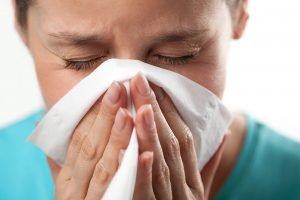Summary
Pertussis, known in English as whooping cough, is a highly contagious respiratory illness caused by the bacterium Bordetella pertussis. It’s called whooping cough because of the distinctive high-pitched “whoop” sound made during coughing fits, particularly in children.
Pertussis spreads through airborne droplets released when an infected person coughs or sneezes. Symptoms include intense coughing fits, fever, facial redness or a bluish tinge due to difficulty breathing, and extreme drowsiness or fatigue. The coughing fits can be severe enough to disrupt breathing and may lead to vomiting in some cases.
Treatment for pertussis typically involves antibiotics to combat the bacterial infection. To relieve symptoms, vaporizers and humidifiers may be used to soothe irritated airways. Pertussis vaccination, developed in the 1930s, remains the best preventive measure. Today, the vaccine is part of the DTaP (diphtheria, tetanus, and pertussis) series, recommended for children and adults to reduce the risk of infection and transmission.
Table of Contents
Symptoms of Pertussis

Image Source: kvennabladid.is
When pertussis, or whooping cough, develops, symptoms typically take 7 to 10 days to appear after exposure. However, in some cases, symptoms may take longer to manifest. Early symptoms are usually mild and resemble those of a common cold. These initial symptoms may include:
- Runny nose. Excess mucus production leads to a persistent runny nose.
- Nasal congestion. Swelling in the nasal passages can result in a stuffy nose.
- Red, watery eyes. Irritation may cause eye redness and tearing.
- Fever. A low-grade fever often accompanies early symptoms.
- Mild cough. Initially, the cough may be mild but persistent.
After one to two weeks, these symptoms typically worsen. Thick mucus builds up in the airways, leading to severe coughing fits that make it difficult to breathe. This progression of pertussis can cause the following additional symptoms:
- Vomiting. The intense coughing fits may trigger vomiting, especially in young children.
- Red or bluish face. Straining from coughing may cause the face to turn red, and in severe cases, a bluish tint may appear due to oxygen deprivation.
- Extreme fatigue. Frequent coughing and difficulty breathing exhaust the patient.
- “Whooping” sound at the end of a cough. The classic “whoop” sound occurs when a person gasps for air after a coughing fit, a defining feature of pertussis.
In infants, pertussis may not cause the typical cough. Instead, it can lead to apnea, which is a temporary pause in breathing that can be life-threatening if not promptly treated.
Recognizing pertussis symptoms early, especially in vulnerable groups like infants, is essential for timely intervention and treatment.
Diagnostic Procedures for Pertussis
Diagnosing pertussis, or whooping cough, involves a combination of clinical evaluation and laboratory tests. Early diagnosis is crucial to begin treatment promptly and prevent the spread of this highly contagious infection. Here are the standard diagnostic procedures for pertussis:
- Medical history and symptom review. The healthcare provider will first review the patient’s medical history and ask about symptoms. Typical symptoms of pertussis, such as intense coughing fits with a “whooping” sound, vomiting after coughing, and episodes of breathlessness, are significant indicators.
- Physical examination. During the examination, the doctor listens for the characteristic whooping sound in the patient’s cough. They may also observe for other signs, such as red or bluish skin due to lack of oxygen, especially in infants and young children.
- Nasopharyngeal swab or aspiration. A sample of mucus from the back of the throat or nasal passage is collected using a swab or suction. This sample is then tested for the presence of Bordetella pertussis bacteria. This method is most effective when performed in the early stages of the disease, within the first 2-3 weeks of symptoms.
- Polymerase chain reaction (PCR) test. The PCR test amplifies the DNA of Bordetella pertussis in the collected sample, making it highly sensitive for detecting the bacteria. PCR testing is one of the quickest ways to confirm pertussis, especially in the initial stages of infection.
- Blood test. A blood test may be done to check for an elevated white blood cell count, which is common in bacterial infections. This test can help support the diagnosis of pertussis, especially if other methods are inconclusive.
- Chest X-ray. If there are signs of complications, such as pneumonia, a chest X-ray may be recommended to assess the condition of the lungs. X-rays are usually performed in severe cases or when symptoms do not improve with treatment.
These diagnostic procedures allow healthcare providers to confirm a pertussis infection, initiate timely treatment, and implement preventive measures to reduce transmission. Early and accurate diagnosis is essential to manage symptoms effectively, prevent complications, and protect high-risk individuals from exposure.
Complications of Untreated Pertussis

Image Source: www.emergencyphysicians.org
Untreated pertussis, or whooping cough, can lead to severe complications, especially in infants, young children, and people with compromised immune systems. If left untreated, pertussis can progress to dangerous health issues that may require intensive care. Here are some of the primary complications associated with untreated pertussis:
- Pneumonia. Pneumonia is one of the most common complications of pertussis, particularly in infants. The bacterial infection can spread to the lungs, leading to inflammation and fluid buildup, which makes breathing difficult and may require hospitalization.
- Seizures. The intense and prolonged coughing fits characteristic of pertussis can lead to seizures, especially in young children. Seizures result from a lack of oxygen due to interrupted breathing during coughing spells.
- Apnea (breathing pauses). In infants, pertussis can cause episodes of apnea, where breathing temporarily stops. This can be life-threatening and often requires emergency medical intervention.
- Brain damage. Severe cases of pertussis can reduce oxygen flow to the brain during intense coughing fits, increasing the risk of brain damage. This can result in long-term neurological issues, including developmental delays and learning disabilities.
- Weight loss and dehydration. Persistent coughing and vomiting after coughing fits can make it challenging for individuals, especially infants and young children, to eat and stay hydrated. This can lead to weight loss and dehydration, requiring medical treatment.
- Rib fractures. Adults and older children with pertussis may experience rib fractures or bruised ribs due to the forceful coughing associated with the illness.
- Secondary bacterial infections. The weakened respiratory system from pertussis increases susceptibility to secondary bacterial infections, such as ear infections and sinusitis. In severe cases, these infections can further stress the body and lead to complications.
Complications from untreated pertussis can be severe and even life-threatening, making early diagnosis and treatment critical. Vaccination remains the most effective way to prevent pertussis and protect vulnerable populations from these serious health risks.
Causes of Pertussis
Whooping cough, or pertussis, is a respiratory infection caused by the Bordetella pertussis bacterium. The infection typically develops in the airways, particularly in the trachea and bronchi.
When B. pertussis attaches to the lining of the respiratory tract, it releases toxins that disrupt the normal functioning of the cells responsible for clearing mucus. This leads to an excessive buildup of thick mucus in the lungs, which triggers the intense coughing fits characteristic of pertussis.
The accumulation of mucus also causes inflammation and swelling in the airways, narrowing them and making it difficult to breathe. This restricted airflow, combined with severe coughing, results in the high-pitched “whooping” sound heard as the patient gasps for air following a coughing spell.
An individual with whooping cough becomes contagious about 6 to 20 days after the bacteria enter their body. The risk of spreading pertussis is especially high once the distinctive whooping cough begins, making early isolation and treatment important to prevent transmission.
Prevention of Pertussis

Image Source: nagelrice.com
Vaccination remains the most effective way to prevent whooping cough. The pertussis vaccine is combined with vaccines for diphtheria and tetanus, commonly referred to as the DPT or DTaP vaccine. This vaccine is administered to infants in three doses by the age of six months, with additional booster doses given at one year and again between the ages of four and six.
Antibiotics may also be prescribed as a preventive measure for individuals exposed to someone with pertussis, even if they haven’t yet shown symptoms. This preventive approach is particularly recommended for high-risk groups, including:
- Healthcare providers. Due to their frequent contact with patients, healthcare providers are at risk of contracting and spreading pertussis.
- Pregnant women. Pertussis infection during pregnancy can lead to complications and put both mother and baby at risk.
- Infants under 12 months. Babies are especially vulnerable to pertussis complications, making prevention critical.
- Individuals with health conditions, such as asthma. Pre-existing health issues can increase the risk of severe pertussis complications.
- Household members of an infected person. Close contact with someone with pertussis heightens the risk of infection.
- Household members of individuals at high risk for pertussis. Preventing transmission to vulnerable individuals in the same household is crucial.
Vaccination, combined with targeted antibiotic prophylaxis, provides a comprehensive approach to preventing pertussis and reducing the risk of severe complications, especially in vulnerable populations.
Risk Factors for Pertussis
The primary risk factor for contracting whooping cough, or pertussis, is not being vaccinated or losing immunity over time. Individuals who have never received the pertussis vaccine are at a significantly higher risk of infection. Additionally, the immunity provided by the vaccine can diminish over time, so older children, teens, and adults who have not received booster doses may become more susceptible to the disease.
For optimal protection, it’s important to stay up-to-date with pertussis booster shots, especially since pertussis can be severe for infants, pregnant women, and people with compromised immune systems.
Pertussis FAQs
Pertussis, commonly known as whooping cough, is a highly contagious respiratory infection caused by the Bordetella pertussis bacteria. Characterized by severe coughing fits and a distinctive “whooping” sound, pertussis can be dangerous, particularly for infants and individuals with weakened immune systems. Vaccination is the most effective way to prevent infection, but understanding the symptoms, risks, and treatments is essential for managing and preventing the disease. Here are some frequently asked questions about pertussis.
- What is pertussis?
Pertussis, or whooping cough, is a bacterial infection that affects the respiratory tract, causing intense coughing fits that can make it difficult to breathe. - What are the symptoms of pertussis?
Early symptoms resemble a common cold, including runny nose, mild cough, and low-grade fever. After a week or two, intense coughing spells begin, often ending with a “whoop” sound as the patient inhales. Other symptoms include vomiting after coughing and, in infants, temporary pauses in breathing (apnea). - How is pertussis spread?
Pertussis spreads through respiratory droplets from coughing or sneezing. It is highly contagious, and close contact with an infected person increases the risk of transmission. - Who is most at risk for pertussis?
Infants, pregnant women, healthcare providers, and individuals with weakened immune systems are at greater risk. Children who are unvaccinated or whose immunity has waned are also more susceptible. - Can pertussis be prevented?
Yes, the DTaP vaccine for children and the Tdap booster for older children, teens, and adults are effective in preventing pertussis. It is especially important for pregnant women and those in close contact with infants to be vaccinated. - How is pertussis treated?
Pertussis is typically treated with antibiotics, which can help reduce symptoms and prevent the spread of the infection. Early treatment is most effective, particularly in vulnerable populations. - How long does pertussis last?
The coughing stage of pertussis can last several weeks, even up to 10 weeks or more. This is why it is sometimes called the “100-day cough.” Recovery is gradual, and coughing may continue after other symptoms have subsided. - Can you get pertussis if you’ve been vaccinated?
While the vaccine is highly effective, immunity can decrease over time. Booster shots are recommended to maintain immunity, but vaccinated individuals who do contract pertussis generally experience milder symptoms. - Is pertussis dangerous?
Yes, pertussis can be life-threatening, especially for infants and those with weakened immune systems. Complications include pneumonia, seizures, and, in severe cases, brain damage or death. - When should I see a doctor for pertussis?
If you or your child experience persistent coughing fits, difficulty breathing, or other symptoms of pertussis, consult a healthcare provider. Early diagnosis and treatment are essential to managing symptoms and preventing transmission.


